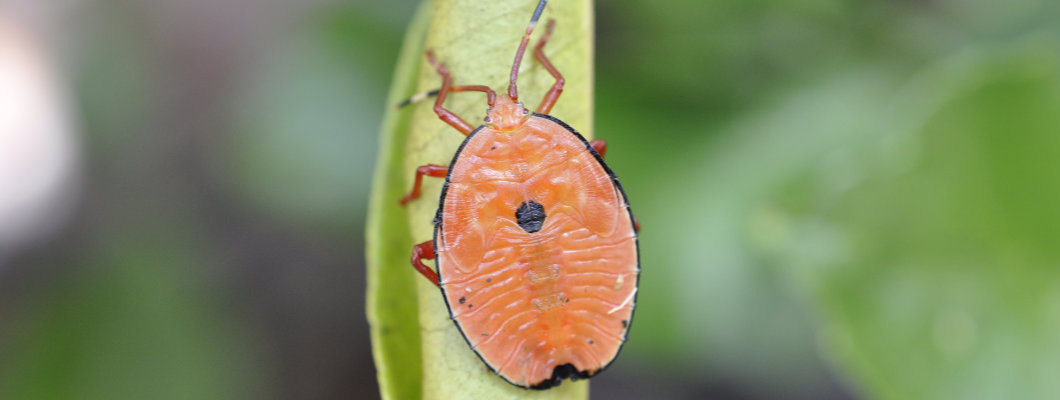
Title image above is copyright © Optimate Group Pty Ltd
First published 3rd November 2021
Introduction
I do enjoy my citrus collection, and they are all healthy-looking and fertilised and watered regularly. But at the same time I’m sadly a very out-of-sight out-of-mind kind of person, and the trees slip in priority, as they are tucked between a sunny brick wall and a fence that gets no traffic unless I’m watering them. Meaning very little attention in winter where they’re almost forgotten and I’m preoccupied with winter projects.
This ignoring of them is amply rewarded with often less than abundant harvests, shall we say! Though occasionally I have really good years, which just rewards the lack of attention and perpetuates the cycle!
But this year, following yet another swarm of bronze orange bug, I decided that it was well-past time learning more about these trees and their pests, and finally doing something about it. So here goes, and I hope this helps you get on top of any infestations you and your trees are suffering!
The Bronze Orange Bug (Musgraveia sulciventris)
The bronze orange bug (Musgraveia sulciventris) is a destructive citrus pest which appears every spring here in Wollongong regular as clockwork to suck the sap out of our citrus trees.
Their range is coastal Queensland and NSW but appear to be extending into Victoria — see here for a map.
An infestation not controlled in time will lead to a tree’s failure to set fruit and/or premature fruit drop, as these bugs are piercing and sucking insects which go for the sap in young shoots and the stems which feed flowers and developing fruits.
Bronze orange bugs are about 2.5 cm long as adults, and are also known as shield bugs or stink bugs. Newly-hatched nymphs are 5 mm long and a well-camouflaged green. Nymphs undergo five moultings to progress to the deep bronze colour of adults.
I thought the word ‘orange’ referred to the vivid orange-coloured nymph stage as in the title photo above — this is when I first notice them and probably everyone else too! — but apparently it refers to their preference for orange citrus trees. Which surprised me as they don’t seem to mind the neighbouring lime and mandarin trees! I might very occasionally see one or two on the also-nearby kaffir lime and finger limes, but I stress ‘very occasionally’. Even though all these trees have been somewhat ignored over the years, I have definitely noticed a very clear pattern of the same trees each and every year under seige while the same other trees are not. More intriguing is that the finger lime is a native host plant for it, yet goes unscasthed. This bug must find the exotic citruses more appetising.
Life Cycle of the Bronze Orange Bug
The life cycle of most insects involves what is called complete metamorphosis, also known as holometabolism. This is the four-stage one we know as egg, larva, pupa and imago (adult). The insect looks completely different at each of these stages — just think of egg, caterpillar, pupa and butterfly!
The bronze orange bug, however, undergoes incomplete metamorphisis, also known as hemimetabolism. This is a three-stage process of egg, nymph and imago (adult). There is no pupal stage, and the nymph resembles very closely the imago, though lacking wings and functional reproductive organs.
Each stage of development in both homometabolous and hemimateabolous insects is marked by moulting, whereby the insect sheds its exoskeleton as it grows and changes between each stage. The period between moults is called an instar. (The larval stage of holometabolous insects and the nymph stage of hemimetabolous insects are actually several mini stages of gradual development, each also marked by moults and called instars).
The bronze orange bug undergoes five moultings and five stages of development/instars. Newly-hatched nymphs are in their first instar, and the fifth instar is the final stage prior to the final moult and becoming an adult.
Females lay clusters of eggs on the underside of new leaves in spring to early summer in Queensland, and mid-summer to early autumn in NSW.
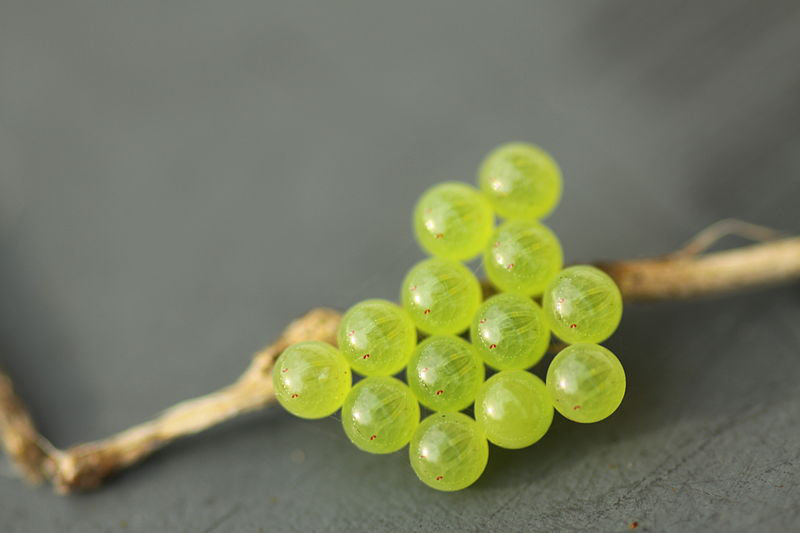
Bronze orange bug eggs. Embryos are visible through the clear egg membranes.
The opaque second egg from the bottom right is unfertilised
Attribution: Emily Sephton from Sydney, Australia, CC BY-SA 2.0, via Wikimedia Commons
The eggs hatch in seven to ten days depending on the temperature. These first instar nymphs don’t feed and remain in groups near the empty egg cases. Possibly to conserve energy and perhaps they lack mouthparts at this stage?
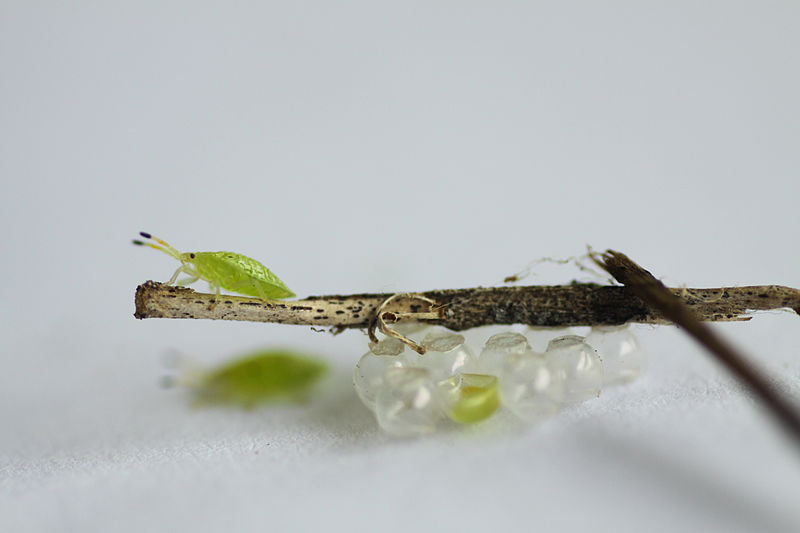
Bright green first instar bronze orange bug nymphs hatching
Attribution: Emily Sephton from Sydney, Australia, CC BY-SA 2.0, via Wikimedia Commons
The fist instar nymphs moult after a week or two, and these now second instar nymphs then spread out amongst the canopy, remaining underneath leaves, where they overwinter.
These nymphs emerge in spring, at the time new flushes of growth appear on the citrus trees. They move to the new shoots to feed and this may be the first visible sign of their presence. The damage would be initially more fresh and green than in the following photos, which were taken much later, but withered shoot tips are a very obvious sign of their presence.
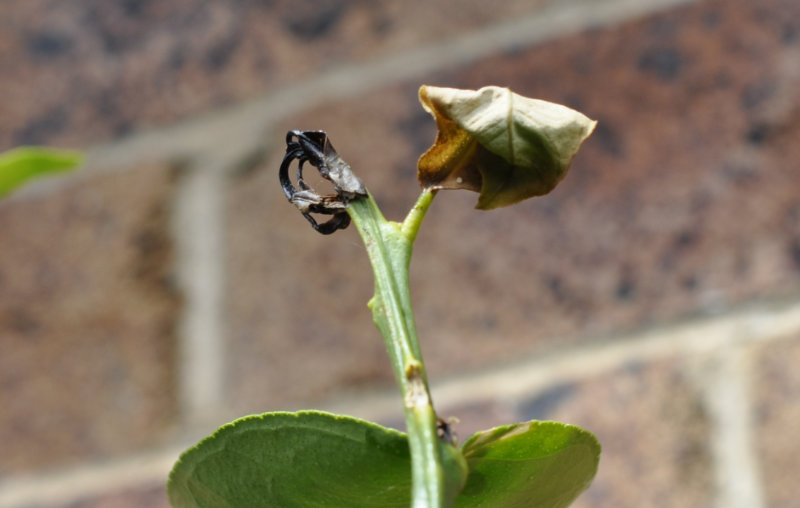
copyright © Optimate Group Pty Ltd
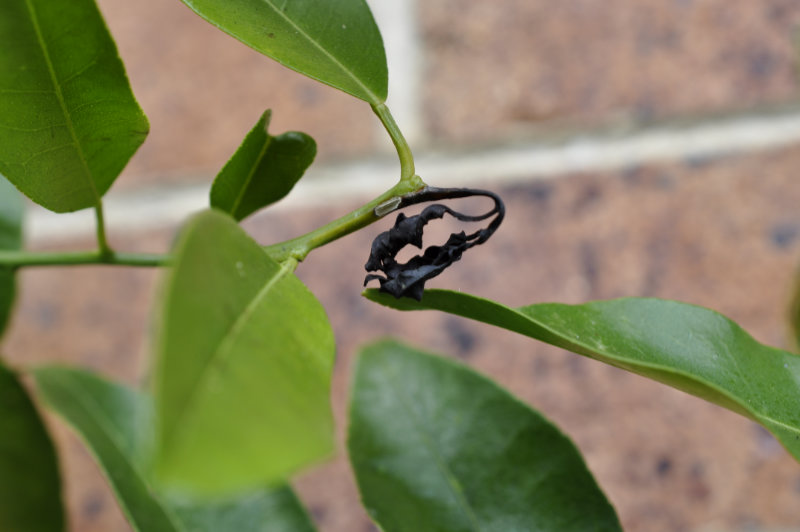
copyright © Optimate Group Pty Ltd
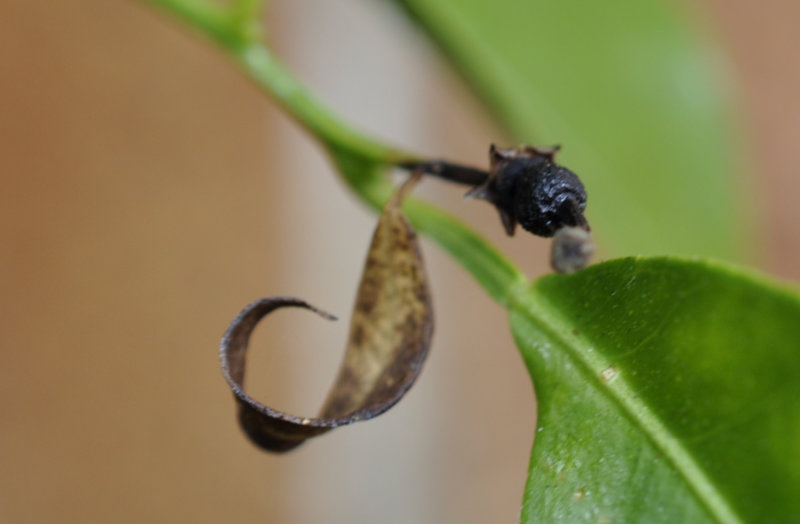
copyright © Optimate Group Pty Ltd
The bugs continue to moult and feed, causing more and more damage, but they do become more noticeable colour-wise and have developed a distinct central black spot by the fourth instar. Fourth and fifth instar nymphs vary in colour, depending on where in the stage they are.
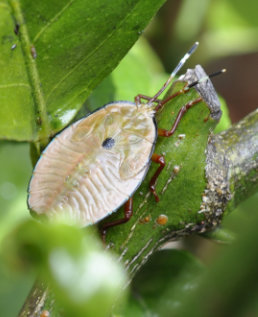
copyright © Optimate Group Pty Ltd
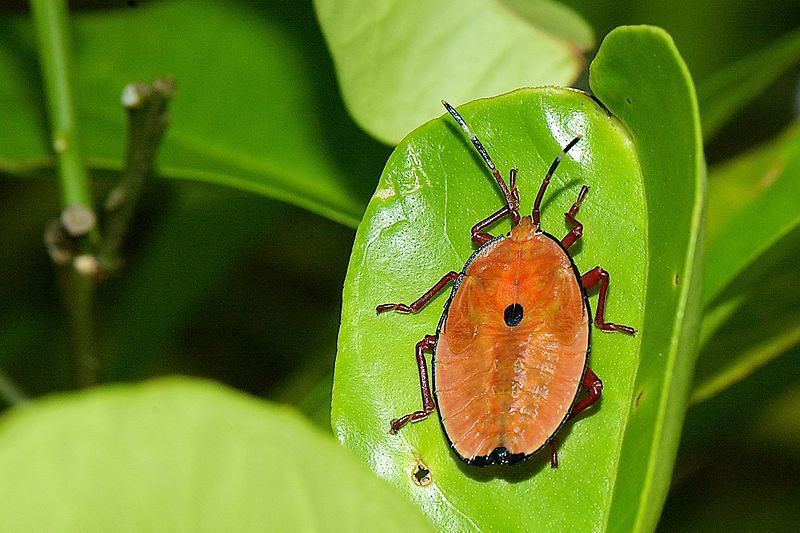
Fourth or fifth instar bronze orange bug nymphs
Attribution: Andy from Sydney, Australia, CC BY-SA 2.0, via Wikimedia Commons
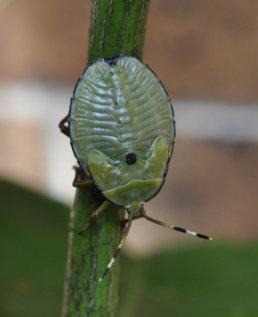
copyright © Optimate Group Pty Ltd
Fifth instar nymphs begin a bright orange, and change to a green-grey colour en route to the deep bronze adult colour.
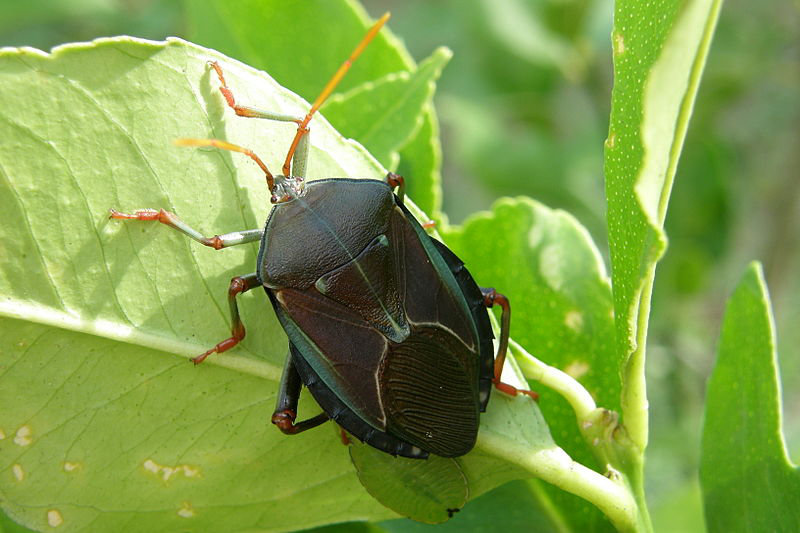
Adult bronze orange bug
Attribution: Jan Anderson from South East Queensland, Australia, CC BY-SA 2.0, via Wikimedia Commons
The cycle repeats when the adults mate from spring to early summer in Queensland, and mid-summer to early autumn in NSW.
Natural Predators
Several species of tiny parasitic wasps lay their eggs in bronze orange bugs’ eggs. The bugs’ eggs change from bright green to a greyish colour as the wasp larva grows and develops inside before emerging as an adult wasp. Assassin bugs, robber flies, and even predatory stink bugs (!) are also natural predators of the bronze orange bug.
Combatting the Bronze Orange Bug
My go-to method for this pest is homemade white oil in a spray bottle, made from just two readily biodegradable, everyday food ingredients found in anyone’s kitchen: detergent and vegetable oil.
There is one caveat, in that while this is a perfect backyard remedy for small numbers of trees of a manageable height, it doesn’t scale to acres of orchards!
And now that I know the life cycle I can see where I’ve gone wrong in the past! I have seen bronze adults in the trees, and removed them with white oil in the past, but probably not before new females had managed to lay eggs. I had no idea they overwintered in the trees, I just figured a new bunch came in every year. I also didn't realise there were so many nymph stages and only ever paid attention when the really obvious orange ones appeared.
Thus it is now clear that you really need to invest a small amount of time over several consecutive days and weeks, and be ever vigilant over summer so as to break the life cycle.
The white oil method really is best-suited to small numbers of trees kept to a manageable height of about 2 or 3 m — this isn’t scaleable to orchards, and would certainly be more difficult and tedious on larger trees regardless of number, as it is a short-range technique otherwise requiring the constant moving and climbing up and down of ladders.
But so long as you can reach all parts of your tree(s) from the ground — even with the aid of an extension rod on a backpack sprayer — it really is incredibly effective!
Unfortunately I had never seen the bugs until they’re a more noticeable colour and larger size, by which stage they’ve already done some damage. But from now on I’ll be paying more attention well into winter on the lookout for eggs, and early spring for the too well-camouflaged first instar nymphs.
Application of White Oil
White oil is fast-acting, non-wasteful, and extremely efficient, so long as you control exactly where it goes. Otherwise, should you spray everywhere with gay abandon, you not only waste it unnecessarily, but also risk killing any predatory insects and spiders around.
This is because the method of action is suffocation through blockage of spiracles, the holes through which gases exchange in insects and arachnids, making this an indiscriminate attack, as all insects and arachnids have spiracles.
It is important to know where the spiracles of a bronze orange bug are for more accurate targetting. They are here, safely tucked under the bug’s broad, flat, shield-shaped top:
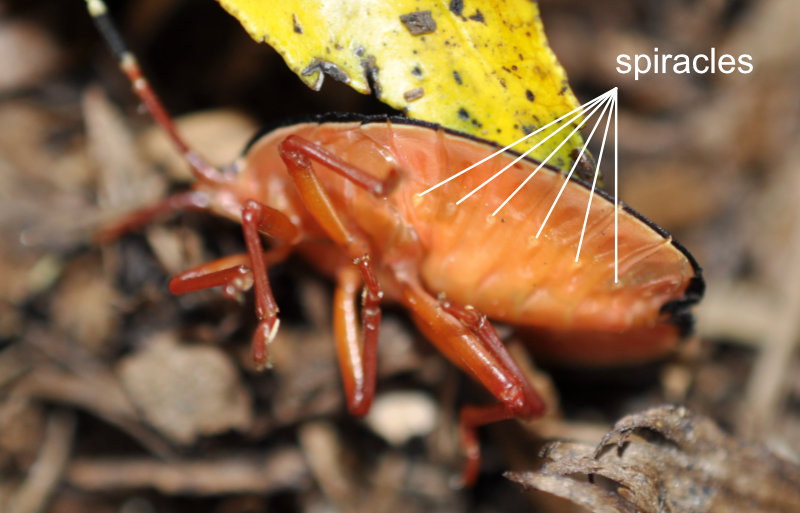
copyright © Optimate Group Pty Ltd
Unfortunately it’s this broad flat surface you’re most likely to see facing you, and which is the easiest to spray! You really do need to get under them to cover those spiracles.
Unfortunately again, these are stink bugs and will spray a sticky, smelly substance in self-defence, and this substance has a reputation for stinging eyes to the point of causing temporary blindness, so exercise caution! I slowly and very gently lift and manoeuvre leaves and branches to expose their undersides before spraying. Results are usually apparent within a minute or two, with bugs at first moving away, and then moving more erratically as if drunk until they lose their grip and fall to the ground dead. Some bugs won’t move at all even after several sprays, but seem locked around onto the stem they’re clinging to. They usually dislodge if you shake the branch or prod with a stick.
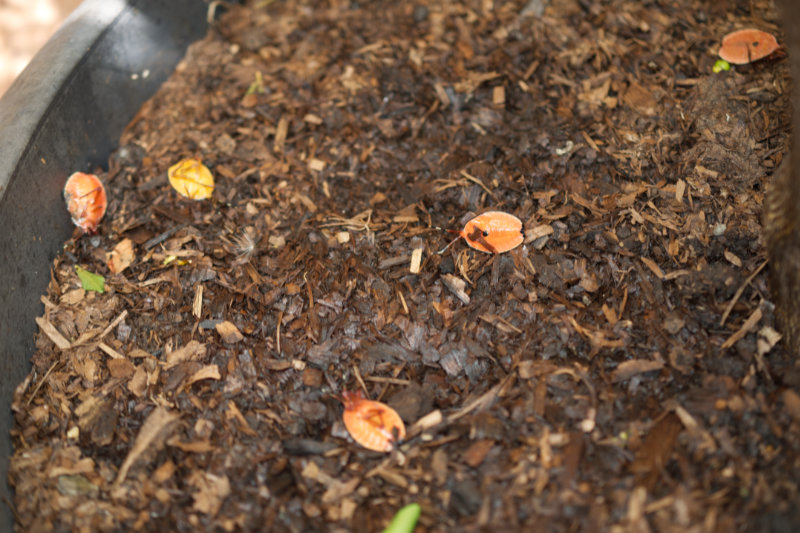
copyright © Optimate Group Pty Ltd
But don’t rest on your laurels just yet! This was my downfall in previous years. I didn’t know to keep looking out for the more camouflaged younger nymphs, and nor did I grasp the importance of adults laying eggs to overwinter.
This time, I went out each and every early morning and late afternoon (spraying during cooler temperatures avoids damage to leaf tissue, looking specifically for all possible nymph colours I missed the previous round. I haven’t yet seen a single adult one, but plenty of fourth or fifth instar nymphs. And each day the numbers were less and less. At a guess I’d say 30 to 40 orange ones amongst three trees when I first started spot-spraying, and maybe another 20 other colours. Day two, maybe ten total, of all, and day three, four! Even now I still go out twice a day as they can be so well hidden and overlooked earlier.
It is so important to be on top of this as soon as you notice any, and to spray daily. The more you get, the less will make it to adulthood to lay those overwintering eggs.
Update: 15th November 2021
I have been checking the trees every two or three days now since writing this on 3rd November, and am still finding the odd fourth or fifth instar bug — and only now finding one to three adult bronze-coloured bugs at a time as well. This just goes to show how out of sight they can be, and how diligent you need to be to keep on top of them!
Update update: 5th January 2022
Don’t stop monitoring! It would seem that adults will continue to fly in from elsewhere and breed in the trees while the weather is still warm. Evidenced by suddenly seeing adults very occasionally in other (non-citrus) trees on the other side of the property they don’t infest, as well as the orange-coloured nymphs reappearing in the citrus trees. At least the orange-coloured nymphs, being easier to see, are a signal to look out for the otherwise-missed adults which produced them.
Update update update: 14th October 2022
Somewhat late here with an update, but for the first time in years I had a bumper Imperial mandarin crop this year, from a tree that hadn’t fruited in years, possibly because of stink bug damage. And bumper finger limes too — maybe the stink bugs were causing damage to those after all in years past?
Spending so much time on them earlier this year kept them more prominent in my mind over winter, and last August every single citrus was pruned right back and given a good dose of slow-release fetiliser and compost ready for spring. Now they are covered in new leafy growth, flower buds are emerging, and I am hoping that these additional nutrients will make them more resistant to future attacks.
The stink bugs are already back in town, and I see the odd one flying out from the tuckeroo with that unmistakeable buzzing sound they make. So far I’ve not seen them on the citrus, but it’s only a matter of time — and now I have white oil on tap and am ready for them!
Update update update update: 1st November 2022
Oh yes they are back alright! It took two days to almost wipe them out, but you are never rid of these pests that easily. For sure they are heavily reduced in number and I am only seeing a handful (if that) per tree each day now, but if I don’t keep on top of them every day I’ll pay the price inside a week. Interestingly they again seem to prefer the mandarin and they were all over both finger limes too, so this could explain the zero yield on those trees the past few years after all. But I still found them on the pomelos, Australian lime, Tahitian lime, Meyer lemon, Eureka lemon, and Blood oranges. The kaffir lime seems the least preferred of all, but I still check it though!
Update update update update update: 12th December 2024
Firstly my sincere apologies to everyone for not acknowledging your comments until now. I had no idea these comments were here as this system doesn't send notifications, can you believe that?!
I’d like to add two more suggestions that aren’t white oil, and which will also work very well for small numbers of trees. One is to net your tree(s) with the fine mesh size for fruit fly. The other is as Robyn and Howard suggest in the comments: picking them off with long tongs and dropping them into a bucket of water. Howard's addition of soap (detergent works too) has the added bonus of breaking the surface tension of the water, which helps them to sink into it. I am doing this myself now, and it can be a superior option to spraying sometimes, especially in extended hot weather where white oil may damage the foliage as mentioned in the main article above. I then tip the lot into the compost afterwards!
Netting is set and forget, but the tongs and bucket option still requires daily inspections of your trees unfortunately so as to keep bug numbers under control.

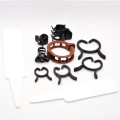

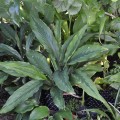
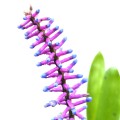

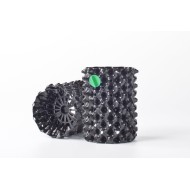

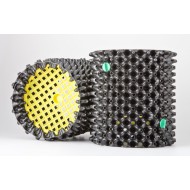
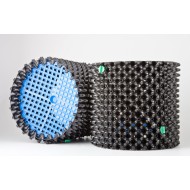
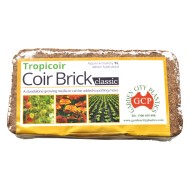
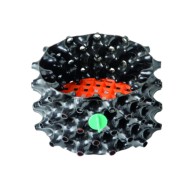

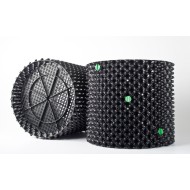
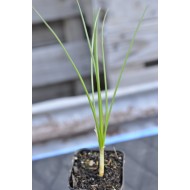
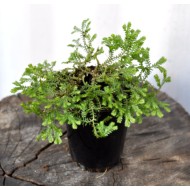

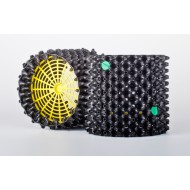
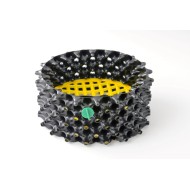
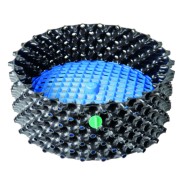
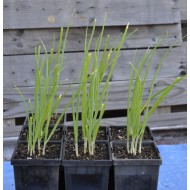

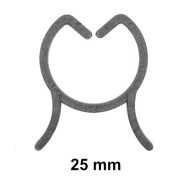

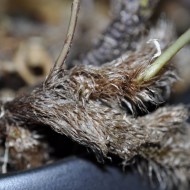
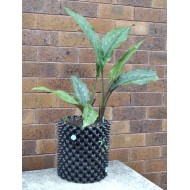

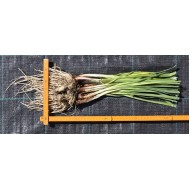

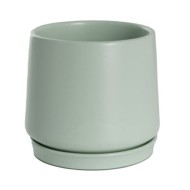
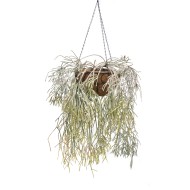


13 Comment(s)
Thanks for the good information. I will start using the white oil treatment and hopefully get rid of most of the stinkbugs. Cheers, simon
My apologies for the late reply Simon, I had no idea everyone's comments were awaiting approval as this software doesn't send notifications - crazy! How did you go with the white oil?
Hi , I have just read your fascinating article on bronze orange bug control and enjoyed the information and story .
I live on the Northern beaches of Sydney and have five citrus trees , and the main one under attack by our friend, ( not) … is my pride and joy the finger lime .
I have had only one good yield in the past three years . Have had a huge amount or flowers and very few fruit to set !
I have noticed quite a few Bronze Orange bugs and not had any success in controlling them buy hand removal .
Can I get your recipe with approximate amounts for a one or two litre spray bottle please !
Loved the article,
Regards
Rob Mayer
Hi Rob, for sure, the recipe is here: https://wollongongnursery.com.au/make-your-own-white-oil You actually make it up as a concentrate in a bottle, from which you take a tablespoon to 500 mL, so two tablespoons into one litre, and four into two litres. It might be a good time to also give your finger lime some liquid fertiliser (liquid is faster acting) as well as removing the bugs. The fertiliser will compensate for all the nutriients lit has lost to the bugs' sucking action, as well as help strengthen its tissues (which makes it harder for the bugs to pierce) and help it set and keep its fruit. Best wishes for a bumper crop this time around! They are a wonderful tree, but boy do you need a hazmat suit around them!
I have them in Canberra. I can smell them on my hands ew! My attack method is a small container of soapy water and long BBQ tongs. Grab and drown the suckers! I will try your white oil method too. They definitely migrate from tree to tree and the trees which aren't looked after in the neighbourhood are where they come from mostly. Just keep on top of them. It's kinda addictive!
Hi Howard, isn't the smell just pungent?! And that irritating whirring sound they make as they fly in - I am so tuned to these pests now I hear and smell them long before I can ever see them! I started doing the soapy water and tongs method very recently, before I saw yours and Robyn's comments, and I've updated the article with this now. It's great that you both took the time to share your tip, thank you so much.
Thank you so much for sharing you experience greatly appreciated.
I have been picking them of with long tongs and dropping in a bucket of water. Will consider making a batch of he white oil, thanks for sharing that also.
And thank you Robyn too, for your input! You may find that adding soap as Howard does will be more effective - would love to hear how you go should you do that! I think there are situations where the tongs and water work best, and times where the white oil is best. Thank you for taking the time to share your experience.
Thanks Kristi for your study. I hate killing anything in my garden and wish there was another way. I followed your oil and detergent solution after reading how destructive these little guys can be. I'm in batemans Bay and haven't seen them until this year. Previously I just got the citrus butterfly impressive caterpillars. This year no catterpillars just these guys.
Thanks again.
Cheers
And thank you Beck for taking the time to write! I hope this works for you, but the tongs and bucket trick is also definitely worth a go as well to see which works best for you.
What proportions of oil:detergent do you use?
Hi Helen, yes the link isn't very clear in the article, but the recipe is here: https://wollongongnursery.com.au/make-your-own-white-oil It is half a cup detergent to two cups of any vegetable oil, shaken until it turns white.nt to two cups of any vegetable oil, shaken until it turns white.
Brilliant article. I have been fighting these pests for years and now feel like I could have a bit of a head start.
Fantastic to hear Bonnie! I know exactly how you feel! Knowledge is power! Also please do try the tongs and bucket of water tip Robyn and Howard mentioned as that too is very effective.
Thank you so much for this detailed story of the stink bug. I have had so much trouble with them over many years. I will be much more vigilant during the other stages of their life cycle from now on.
And thank you Bob! Yes, it's a game-changer understanding their life cycle and makes all the difference. Best wishes for much success!
Thank you so much for this informative article that answered all my questions about the infestation in our backyard citrus trees. We’ve lost 2 crops now and I honestly couldn’t figure how else to go about it. Looking forward to trying some solutions and really enjoyed the friendly tone in which this was written
And thank you Katie for the kind words! I know how incredibly depressing it is to lose a whole season to these pests. Not only the fruit but the foliage and stem damage too which sets them back. I've updated the article to include netting and tongs-and-bucket as two other options that may be worth a try too.
We’ve just dealt with a huge infestation!!! 1000s caught using a wet/dry vacuum cleaner with detergent and water in the tank!! Very effective, thanks for your informative article.
Now *that* is ingenious Carol, thank you for the tip!
I actually spray them off the tree with a hose which I connected to an extra strong nozzle . They can’t withstand the strong stream of water and once they are on the ground I drown them with more water. Some, especially the younger, soft bugs, are already dead when they were hit directly by the stream. But it also has to be done regularly and only after the sun does not shine on the trees, because otherwise the leaves get burnt by water with sun…
I actually do this with all my plants, for softer leaves you just have to adjust the power stream, otherwise the leaves can fall off as well and the plant gets damaged..
But this is a very effective and easy bug control, because you don’t have to spray with the white oil at all and holding and directing a hose is much easier than sprays or tongues!
Perhaps some of you like to try my method
I 'm loving this Leslie, certainly sounds like one of the more...satisfying methods out there!
Thanks for writing this, it's very helpful for those of us who want to avoid chemicals in the garden. I'm about to use your White Oil solution for a current infestation. There are so many 4th/5th fifth Instar Bronze Orange Bug Nymphs on my lemon tree, from a distance it looks like it's flowering red buds!!! Can you confirm what type of detergent you're referring to? Is it dishwashing liquid or laundry detergent? All of the products I use in the home are of the eco variety. Based on your description of the affect of the White Oil solution, would you recommend I purchase a retail brand that contains surfactants? Thanks, Ariel.
Hi Ariel, thank you in return, and may I extend credit to everyone else, whose input makes this post all the better with every comment!
Yes, dishwashing liquid - and thank you for pointing out this ambiguity - that white oil post has now been updated, thank you again.
There's every chance your eco products also contain surfactants, as a surfactant is simply a substance which enables other substances to mix that otherwise wouldn't. This is what gives them their cleaning properties.
If you'd like to share the ingredients I could maybe determine the surfactant for you?
Best regards, Kristi
I just found these pests today (orange-coloured) , while tending to my potted calamansi(calamondin) here in Sydney! It gave me a scare once I found out what they are and what their line of defence is. I have not been fortunate with my citrus, this being the only survivor. I felt like crying while thinking maybe this is a sign that I should stop growing them. It sounds melodramatic, but I was so despondent. I gathered up some courage and did the white oil spray you suggested. 4 down - 0 left, for now.
Im still in shock, but thought that I should write to thank you.
Thank you so much in return Zelda! Yes, they really are that bad a pest and we've all been there! Really happy to hear that you have them under control, but be ever vigilant as they have an incredibly short life cycle and come back, and back, and...
Leave a Comment